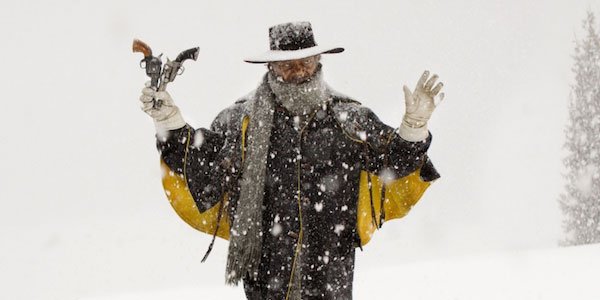The Hateful Eight Needs To Be Seen In 70mm, Despite The Risks

In the coming weeks, cinema fans will be presented with two different ways to see the brand new Quentin Tarantino film, The Hateful Eight. Beginning on Christmas Eve, a special nationwide "roadshow" will begin, with theaters around the country adapting their projection systems so that the feature can be shown in its full 70mm glory – and then one week later on New Year’s Day it will be going wide release and will be available everywhere in its digital format. Truthfully, the movie is worth checking out in either format, as it happens to be one of the best that Tarantino has ever made, but you’ll also be doing yourself an extreme disservice if you don’t go to see it as it was truly meant to be shown.
It’s at this point I should mention that I have not yet seen The Hateful Eight in its full 70mm presentation. When the film screened for press a few weeks ago, the projection was supposed to be in the expanded format – and was before intermission – however, technical issues forced a change-over to the digital version after the short break. But while I didn’t get to see the entirety of the film in its specialized presentation, I am also one of the few people on Earth who has seen both versions of the movie back-to-back, and can tell you that there is a very big aesthetic difference between the two.
When the film restarted, I was honestly shocked by the notable change to the presentation of the movie – the digital version practically looking as though the screen had been covered in a single layer of plastic wrap. While I didn’t miss the blurriness that came as a result of the faulty machinery, I couldn’t say the same for the special grittiness that comes only from legit film, which was replaced by a clean sheen. Gone was the specialized element that helped Tarantino tie the film back to the experience of watching classic westerns on the big screen, and suddenly it looked much more like a project from the modern era. I can’t say that it irreparably hurt my experience watching and enjoying the movie, but I was also very aware that I wasn’t not watching The Hateful Eight as it is truly meant to be watched.
Gorgeous as the work is, it is important to mention that there is a certain degree of risk involved with attending a screening of The Hateful Eight, and I experienced the downside first hand. Being a projectionist used to require a certain amount of professional skill, but that hasn’t really been true since digital equipment took over our nation’s movie theaters and could be operated with the click of a button. The people showing the 70mm version of Quentin Tarantino’s new movie will likely be inexperienced both in handling actual film, and operating the equipment. Surely theaters are doing what they can to get their staffs ready for the release, but their mistakes will affect your experience.
Then there are the projectors themselves – which aren’t exactly fresh out of the box pieces of technology. The first half of my Hateful Eight screening was hampered because the gate on the projector broke, resulting in some scenes being weirdly out of focus. It’s hard to imagine this happening a lot nationwide, but given my first-hand experience, it is worth pointing out as a potential issue that could wind up having an impact on screenings.
If the spectacular presentation and the risk of technical issues leave you feeling 50/50 about seeing The Hateful Eight in 70mm, let the tie-breaker be the simple fact that the roadshow version is the version that you’re really supposed you to see. Quentin Tarantino is far and away one of the most vocal proponents of classic film over digital, and he went above and beyond in making his latest in the same style as the classics during the production and post-production processes.
If you’re already making plans to see The Hateful Eight in theaters, do so by catching a 70mm screening – and even if you’re on the fence about it, you should be proactive and go. Nowadays it’s tremendously rare for any filmmaker to try and craft a pure cinematic experience that’s not based around either IMAX or 3D, and not just the quality of what’s been accomplished, but also the effort that was put into it needs to be celebrated. This is a limited but very special opportunity, and one that should be seized.
Your Daily Blend of Entertainment News

Eric Eisenberg is the Assistant Managing Editor at CinemaBlend. After graduating Boston University and earning a bachelor’s degree in journalism, he took a part-time job as a staff writer for CinemaBlend, and after six months was offered the opportunity to move to Los Angeles and take on a newly created West Coast Editor position. Over a decade later, he's continuing to advance his interests and expertise. In addition to conducting filmmaker interviews and contributing to the news and feature content of the site, Eric also oversees the Movie Reviews section, writes the the weekend box office report (published Sundays), and is the site's resident Stephen King expert. He has two King-related columns.
